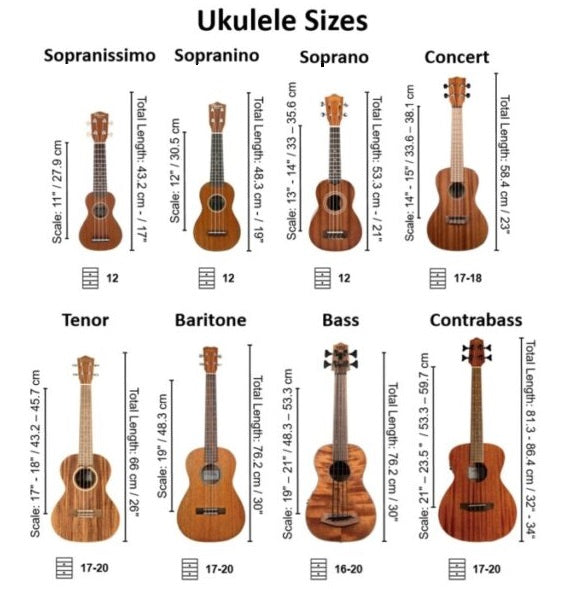
Introducing The Ukulele Family
Share
Soprano Ukulele
Soprano ukes have a recognisable and charming bright ‘Hawaiian’ vibe. Many beginners start out playing a soprano, their compact size makes them ideal for younger players and those who prefer a tight fret spacing.
They are great for strumming chords but not ideal for playing single notes - typically having only twelve frets and little playing space on the fretboard.
The compact size of soprano ukuleles mean they are easy to transport – making them an excellent musical companion for your next holiday or around the beach campfire.
If you’re looking for a ukulele that’s perfect for strumming chords and has that classic ukulele sound, the soprano size is a great choice. Just keep in mind that it may not be the best option if you want to play intricate melodies.
Common soprano ukulele tuning: G, C, E, A (Re-entrant)
Concert Ukulele
Concert ukuleles offer a good compromise between soprano and tenor ukuleles. They strike a harmonious balance between the two, making them a favourite among many players.
Featuring larger fret spacing and wider neck, they are easier to play, with more space on the fingerboard to master chord shapes. The concert size is a great choice for players of any experience or skill level.
A larger body means they naturally produce a full sound and warm tone with more mid-range emphasis than the soprano. They’re therefore excellent accompaniment ukuleles that blend well alongside other instruments.
Concert Ukuleles usually have between seventeen and eighteen frets. Whether you’re drawn to strumming sweet chords or plucking melodious single notes, the concert ukulele offers a versatile and delightful experience.
Common concert ukulele tuning: G, C, E, A (Re-entrant)
Tenor Ukulele
Tenor ukuleles are the largest of the three common sizes of ukulele (soprano, concert, tenor). Tenor ukuleles are often the go-to for professional players and their larger size and inherent playability offer an excellent choice for players wanting to experiment with different playing styles. Having between seventeen and twenty frets, there is ample space on the fingerboard. They perform particularly well in a ukulele duo or trio – occupying the lower frequencies wonderfully.
Their larger size means they deliver a deep, resonant and bass-y tone with excellent volume and can be tuned to high-G (the same as soprano and concert ukes) or low-G where the G string is tuned down one whole octave for a mellower tone.
Common tenor ukulele tuning: G, C, E, A (Re-entrant)
Baritone Ukulele
Due to its larger size and lower tuning, the baritone presents a unique playing and tonal experience from the traditional ukulele sizes, with many avenues for exploration.
Featuring a larger body and extended neck, the baritone ukulele is similar in size to a tenor guitar (without the fifth and sixth string), bridging the gap between ukuleles and guitars. Usually, Baritone Ukuleles have between seventeen and twenty frets
Guitar players may quickly find it to be very familiar: the Baritone Tuning is identical to the bottom 4 strings of standard guitar tuning. Many chord shapes and riffs may be very quickly transferable from guitar to baritone ukulele.
The baritone ukulele loses the transportability quality that soprano and concert ukuleles have but if you’re drawn to a mellower, guitar-like tonality and a broader sonic range, the baritone ukulele may be the perfect choice for your musical journey.
Common baritone ukulele tuning: D, G, B, E
Bass & Contrabass Ukulele
Bass and Contrabass Ukulele have a larger body and a longer neck that their siblings.
The bass and contrabass ukulele are relatively new on the scene. Although scale length is only marginally longer than that of a baritone, they use specially designed strings which are thicker in order to achieve lower bass frequency notes.
Tuned the same way as a bass guitar, they are a great instrument for bassists to pick up and immediately transfer their skills to. They are played in the same style as bass guitar, with strings that are plucked rather than strummed. Their low and warm tone offers an excellent option for ukulele ensembles to support the low-end of their overall sound.
Common bass ukulele tunings: E, A, D, G
Sopranissimo, & Sopranino Ukulele
Sopranissimo and Sopranino are even smaller than the Soprano, with 11″ and 12″ scale lengths respectively. These sizes do not sound particularly pleasant and don’t intonate well, making them unpopular.
Which Ukulele Is Right For You?
There are many different choices, including various woods, from solid to laminate.
Tenor is always popular, as it gives a broader playing experience due to its larger size. If you want the original bright, happy sound of the ukulele, and will only be playing songs by strumming chords, the soprano is your best option.
If you are still not sure you can go to an intermediate point, which is the concert ukulele. It’s a versatile size, neither too big nor too small, suitable for both strumming chords and playing single notes.
If you already play bass guitar then a bass or contrabass ukulele would be a good starting point.
Your choice should also consider your hand size and personal preference. If you’re taller with large hands, a tenor might be better. If you’re smaller with smaller hands, consider a soprano or concert.
In case you’re ordering online without trying them out physically, a concert is a safe bet.
